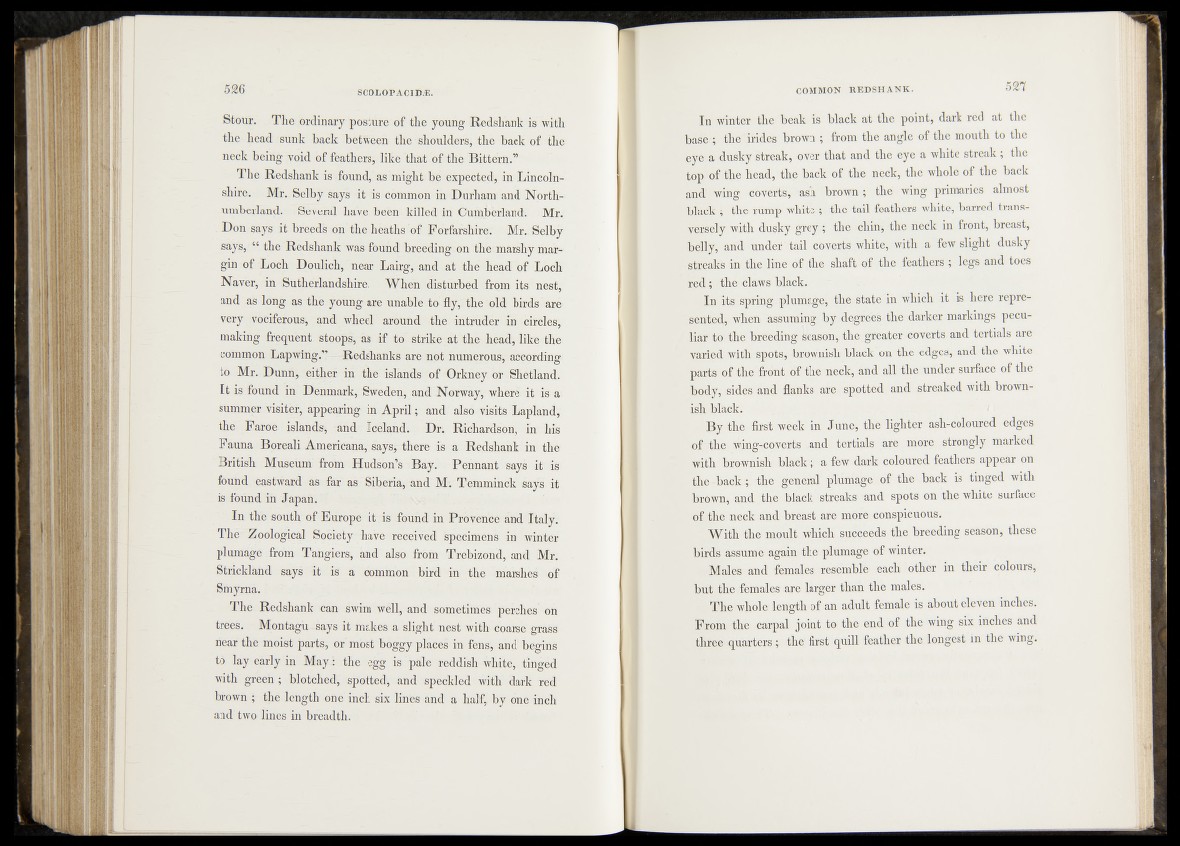
Stour. The ordinary posture of the young Redshank is with
the head sunk back between the • shoulders, the back of the
neck being void of feathers, like that of the Bittern.”
The Redshank is rfound, as might - be - expected, in Lincoln--
shire. Mr. Selby says it is common in Durham and Northumberland.
Several have been killed in Cumberland. Mr.
• Ron says it breeds bn the heaths of Forfarshire. Mr. Selby
says, “ the Redshank was found breeding:on the:marshy mar-
gin of Loch Doulich, near Lairg, and at the head of Loch
Naver, in Suthérlandshirè. When disturbed from its nest,
and as long as the young are unable: to'ofly, the'old birds are
very vociferous, and wheel around the intruder in circles,
making frequent stoops, às if to' strike , at the head, like the
common Lapwing.”-—Redshanks are not numerous, according
to Mr. Dunn, either in the islands of Orkney hr Shetland.
I t is Found in Denmark, Sweden, and Norway, where it ûs à
summer visiter, appearing in April ; and also visits Lapland,
the Faroe islands-, and Iceland; Dr; Richardson* in his
Fauna Boreali Americana, says* there. is ;a Redshank : in the
British Museum from Hudson’s Bay. Pennant&says ;it3 is
found eastward as far as ’ Siberia, and'M-. Temminck says it
is found in Japan.
In the south of Europe it: is-found in Provence and Italy.
The Zoological Society have received speöimèös in winter
plumage from Tangiers, and also from Trebizond, and Mr.
Strickland says-it is a common’ bird in the -marshés® of
Smyrna. '
The Redshank can swim well, and sometimes perches on
trees. Montagiusays it inakes a slight nest with coarse grass
near thé moist parts, or'most boggy places in fens, and‘ begins'
to lay early in Mayi the egg is pâle reddish-white, tinged
with green; blotched, spotted, and speckled with dark red
brown ; thé length one inch six linés and a half, by one inch
In winter the beak is black at the point, dark red at the
base ; the Indes brown ; from the angle of the mouth to the
eye a dusky Streak, over that and the eye a white streak; the
top of the head, the back of the neck, the whole of the back
and wing coverts, ash brown; the wing primaries almost
black ; the rump white ; the tail feathers white, barred transversely
with du^ky grey;; the chin* the neck in front, breast,
-belly, and under' tail coverts white, with a few slight dusky
• streaks in the dine of the shaft o‘f the feathers ; legs and toes
re d ; ;the claws black.
In its .springs plumage, the state in which it is here repre-
"Sßnted, when assuming^by degrees the darker markings peculiar
to’ the‘ breeding Reason, the. greater coverts and tertials are
varied with spots, brownish black on the edges, and the white
■ parts of the front .of the neck, and all the under surface of the
. fr®.dj%sides and flanks are spotted and streaked with brownish
black.
By the first wéék in Jfihe, the lighter ash-coloured edges
ofrthes1 wipg-tcoyerts -.and tertials are more strongly marked
with brownish black; a few dark coloured feathers appear on
fehe-'baek; “the general plumage of thé back is tinged with
brown, and .the black streaks' and spots on the white surface
ofitJk©<4^ek, and breast are more conspicuous.
With the moult which succeeds, the breeding season, these
birds assume again the plumage of winter.
Males and females#resemble each other-in their colours,
but the femalesfjare larger than thé rhälesv -
The whole: length of :an adult female is about eleven inches.
From the carpal joint to the end of the wing six inches and
, three quarters; the; first quill feathet the longest in 'th e wing.